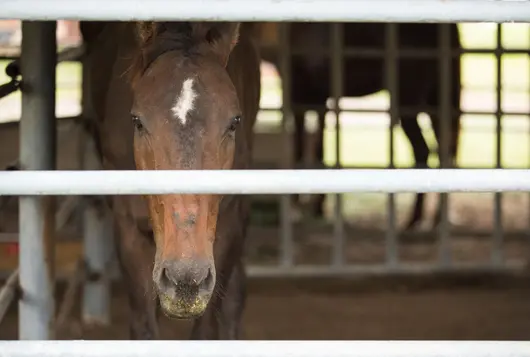Intake Pathways for Open-Admission Horse Adoption Agencies

Opening your program to all horses in need is a great way to support owners, their horses, and your community by potentially decreasing neglect and preventing horses from going to low-end auctions.
It also means you must be prepared with clear pathways for each animal at intake.
As an open-admission organization, you’ll need to be ready for horses of every breed, size, temperament, training level, age, and health status.
Learn from the Owners
You can learn important information about horses from the people relinquishing them.
Here are a few things to consider before intake to help things run smoothly:
- Can the owner humanely and safely keep the horse for a week or two if your capacity is currently high?
- Is it possible to do a video call with the horse owner to ensure you’re both in agreement as to what’s best for the horse?
- Can you send your veterinarian to the property before intake to assess whether the horse’s welfare is best supported by rehoming, especially for very old and infirm horses who may be best served by euthanasia? If needed, the veterinarian can also vaccinate and prep the horses for intake to avoid the need for quarantine.
Create Intake Pathways
Consider grouping new horses into three categories:
- Fast track
- Training, rehabilitation, and monitoring
- Euthanasia
Fast Track
Horses who arrive at your facility with basic training and in good health should be rehomed as soon as possible.
Follow these steps to help home your equines ASAP:
- Conduct and record their Basic Behaviors Profile.
- Capture compelling photos.
- Write captivating bios
- Get the photos and bio of every horse up on your website and social media channels within a few days of receiving the horse.
Moving these “fast-track” animals through your system efficiently will allow you to help even more equines.
Training, Rehabilitation, and Monitoring
Some horses will arrive at your facility with medical or behavioral issues.
If the horse is safe and the prognosis is fair, marketing the horses while they’re in rehab/retraining can help to attract adopters ready to adopt as soon as the horse is available.
Share the Basic Behaviors Profile with potential adopters so they can see what stage the horse is in. We’ve found adopters and fosters often want to be a part of the healing process, and you can reduce a horse’s length of stay by them in the process.
It’s also important to consider that there are adopters of all skill levels who may be willing and able to adopt harder-to-place and special needs equines.
Building a training/rehab plan for each horse will help assure they progress through their rehab and are adopted. Tracking each horse is vital to ensure their welfare and that they don’t stagnate without an outcome. Creating written protocols and weekly rounds logs will help you document each animal’s progress over time. If improvement continues at your predetermined pace, you can animals can place the horse up for adoption.
Euthanasia
If a horse meets the AAEP criteria for euthanasia, whenever possible, euthanize the horse at their current home to avoid the stress and discomfort of transport. Sometimes health and behavior challenges are not identified until after the horse has entered your program. Having clear euthanasia guidelines like Harmony Equine Center will help you make difficult health and behavioral decisions to support the well-being of the animals in your care and the sustainability of your organization.
For a visual representation of these pathways, download the Sample Intake-Outcome Equine Flowchart.
Downloads
Download AllWe have lots more on this subject:
